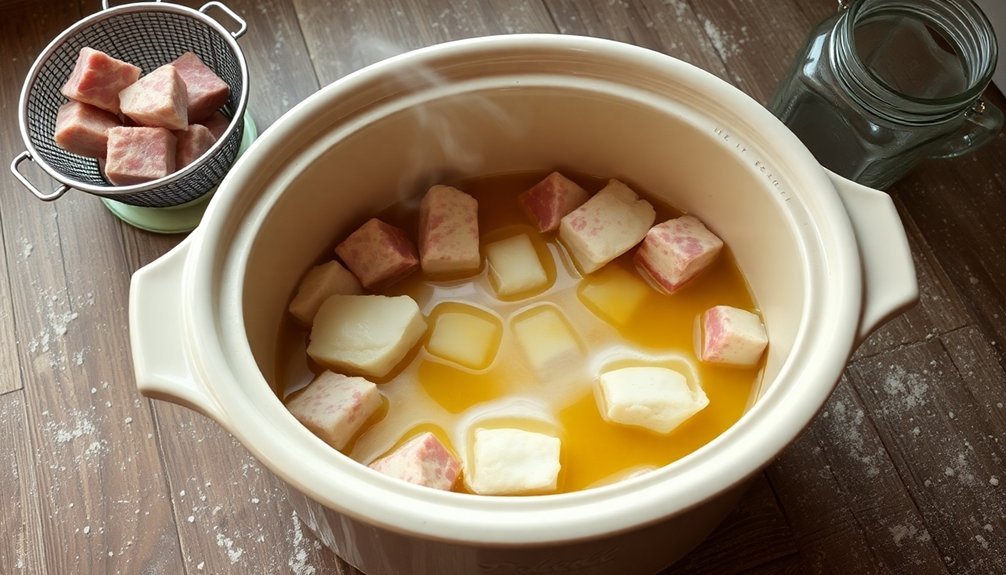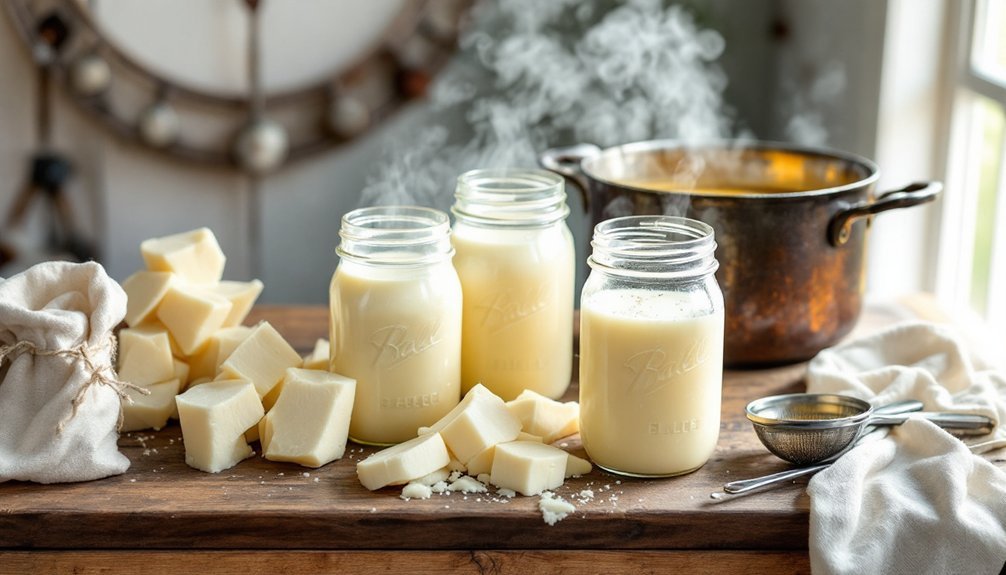Three proven homestead methods for rendering pure tallow include using a slow cooker, wet rendering on the stovetop, and the double-boiler technique. You'll get the best results with high-quality beef suet, proper temperature control (130-140°F), and careful straining through cheesecloth. Each method requires 2-8 hours of rendering time, with the slow cooker being the most hands-off approach. Understanding the nuances of each technique will help you master this essential homesteading skill.
The Classic Slow-Cooker Method: A Time-Tested Approach

When it comes to rendering tallow at home, the slow-cooker method stands out as one of the most reliable and hands-off approaches.
You'll want to start with high-quality beef suet, cutting it into small chunks or grinding it for faster rendering. Add enough water to cover the beef fat, along with a few tablespoons of salt to help purify the mixture.
Set your slow cooker to low heat and let it work its magic for 6 to 8 hours. During this time, the fat will gradually melt and separate into a clear liquid.
Once the rendering process is complete, strain the tallow through a cheesecloth-lined metal strainer to remove any impurities. Let it cool and solidify before transferring to clean jars for long-term use.
The Wet Rendering Stovetop Technique

Unlike its slow-cooker counterpart, the wet rendering stovetop technique offers greater control over the tallow-making process. You'll start by combining beef fat with water and salt (8 cups water and 2-3 tablespoons salt per 4-5 pounds fat). Keep the mixture at low heat (130-140°F) throughout the rendering process.
| Time | Temperature | Action Required |
|---|---|---|
| Start | Room temp | Combine ingredients |
| Hour 1 | 130-140°F | Begin melting |
| Hour 2-3 | 130-140°F | Stir occasionally |
| Hour 4 | 130-140°F | Check clarity |
| Final | Cooling | Strain mixture |
Once your liquid tallow is clear, strain it through a cheesecloth-lined strainer to remove solids. Let the final product refrigerate overnight to solidify. Any remaining impurities will settle at the bottom, allowing you to separate them for the purest tallow possible.
The Double-Boiler Pure Tallow Process

A double-boiler setup offers the most controlled environment for rendering pure, clean tallow.
You'll want to place your chopped beef fat in a heatproof container positioned over boiling water, ensuring the fat doesn't make direct contact with the water below. This gentle rendering method maintains an ideal low temperature of 130-140°F, preventing burning while minimizing unwanted odors.
For best results, use one pound of beef fat per quart of water in your bottom pot.
Once melted, strain your tallow through cheesecloth or a fine mesh strainer to remove impurities. You'll want to repeat the straining process to achieve the purest, whitest product possible.
Transfer your rendered tallow to clean, dry storage containers and let it cool completely for long-term preservation either at room temperature or in your refrigerator.
Frequently Asked Questions
Is It Better to Render Tallow Wet or Dry?
You'll get better results with wet rendering. While it takes longer, you're going to have cleaner, purer tallow with less odor. It's worth the extra time, especially if you're using it for skincare.
How to Render Tallow at Home?
Cut beef fat into small cubes and place in your slow cooker on low. Add water and salt, then cook for several hours until clear. Strain through cheesecloth, and store in sealed glass containers.
What Is the Best Way to Purify Tallow?
You'll get the purest tallow by wet rendering with water and salt, straining through cheesecloth-lined metal strainers twice, and allowing it to cool. This process removes impurities and creates odorless, white tallow.
Why Add Salt When Rendering Tallow?
You'll want to add salt when rendering tallow because it draws out impurities and moisture, enhances flavor, prevents burning, and helps preserve your final product. It's also great for maintaining lower cooking temperatures.
In Summary
Whichever method you've chosen, you'll find that rendering your own tallow isn't just cost-effective – it's deeply satisfying. You're now equipped with three reliable techniques to transform raw fat into pure, shelf-stable tallow. Whether you're using it for cooking, candlemaking, or soap crafting, your homemade tallow will elevate your homesteading projects while keeping traditional skills alive on your modern homestead.





Leave a Reply